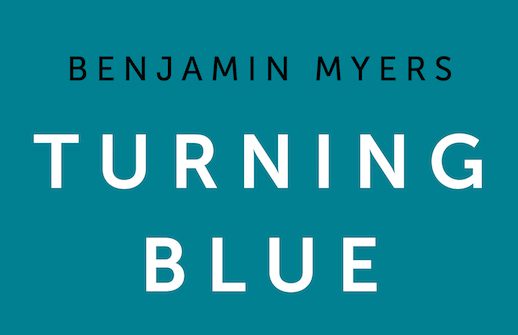Turning Blue by Benjamin Myers
(Moth publishing, paperback, 336 pages. Out now and available here.)
Review by Katharine Norbury
I ticked a few things off my literary bucket list this summer. I visited the grave of Sylvia Plath when I was staying at Lumb Bank, the house bought by Ted Hughes. Whilst there, I explored the leafy valley floor, poked around the old industrial installations, familiarised myself with the deep scars and quarried cliffs, the woods and the exquisite meadows planted by the Yorkshire Dales Millenium Trust to facilitate the passage of pollinators. A few weeks later, I began Wainwright’s coast-to-coast walk with my sixteen-year old daughter, striding purposefully from St Bees Head, again in the direction of the dales. Thank goodness I hadn’t read Benjamin Myers’ Turning Blue before I set out or I wouldn’t have been able to do any of it. Because Turning Blue takes this once seen, never to be forgotten, iconic and literary landscape, which includes the coast-to-coast footpath, a landscape immortalized by Wainwright, Plath and Hughes, and makes it anew, turns it inside out, turns it thoroughly blue. Blue in the sense of sorrow, blue in the sense of porn, blue in the sense of rot, decay and death.
Working within the genre of crime fiction, and yet with a prose style that at times reads like poetry, Myers spins a tale of torment that creaks into other, older narratives. He creates a novel that is both environmentally and ecologically prescient, yet at the same time fully inhabits the long established realm of Yorkshire gothic. Turning Blue shares a clear family resemblance with both Bram Stoker’s Dracula (in the sense of all your worst nightmares coming true – in Yorkshire) and, in its tortured, half-formed, marginalised anti-hero, with Emily Bronte’s Wuthering Heights.
I’m not sure if I have ever heard anyone say: “cleanliness is next to godliness” and mean it but Myers’ reeking anti-hero, Steve Rutter, is so uncouth, in every sense of the word, that personal hygiene constitutes a plot point. Dirt, filth and muck: physical, emotional and spiritual, drive the action of Turning Blue and become synonymous with the depravity of the underworld of hard core pornography that Myers has made his subject.
The story begins with the imminent suicide of Rutter as he sails out onto a man-made reservoir, with its own man-made microclimate, to join the remains of a girl he has murdered. This isn’t a whodunit, so much as a whydunit, a “how did we get to this place?” Between the polarities of D. I. Brindle, fastidiously clean, his every move dictated by his obsessive compulsive disorder, his pre-cooked food in Tupperware boxes and Rutter, with his bleeding gums and blackened nails, who seems never to have seen a bar of soap in his life, Myers unpicks our deepest taboos and stares so long and so hard, that they start to appear normal. We are reminded of that now infamous son of Leeds, Jimmy Savile, in the character of Loveable Larry Lister, who crouches at the heart of Myers’ narrative. But everything that came out about Savile after his death is merely the tip of the iceberg for Larry Lister. It’s what’s going on beneath the surface that feeds Myers’ imagination.
Ultimately, though, this is a portrait of loneliness, of disconnection, of what happens when we fail to touch one another in an ordinary, familiar way. There is not one “normal” heterosexual relationship in the book, and the only “wholesome” female character is a murder victim (and coast-to-coast walker!). Turning Blue has something of Paul Haggis’s 2004 movie Crash – a portrait of a dysfunctional L.A. society where the only human contact seems to come when people accidentally yet physically collide into one another, without forethought, without intention.
Underneath all of this is the whirring hum of wind turbines, the chasm of the man-made reservoir and an awareness of the continually changing use of a rural yet industrialised landscape, and of our ultimately pointless human endeavour to control every aspect of it, as well as those who inhabit it, be they human, wild, cultivated or inanimate.
Not for the squeamish, fainthearted or easily shocked, Turning Blue is a brave and utterly uncompromising novel which positions Benjamin Myers alongside the great names of crime fiction. He has earned his metaphorical seat on the bench, snuggled in between Val McDermid and James Ellroy.
